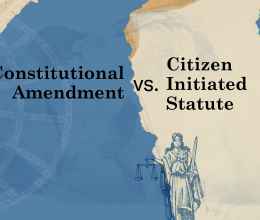Sentenced to ten years, out in two. Outrageous!
And false.
The myth that prisoners serve small fractions of sentences is one of the most destructive falsehoods driving the tragedy of mass incarceration. In Ohio and elsewhere, the use of parole and probation has shrunk to levels that can only be described as harmful to us all.
In a word: Outrageous!
A new 106-page ACLU report, False Hope: How Parole Systems Fail Youth Serving Extreme Sentences, documents the counterproductive decline in the nation’s parole systems, especially for young people sentenced to absurdly long prison terms, often life sentences. Sadly, Ohio makes many appearances in this heartbreaking report.
Congress abolished parole in the federal justice system in 1986, under the propagandist term “Truth in Sentencing.” A few years later, Congress bribed states to do the same by promising $9.7 billion for prison construction to states which did the same. Ohio took the bribe, as did most states.
The elimination of parole has fueled mass incarceration in ways few appreciate. It doubled actual time served in a way that the public did not notice and even today does not realize. Today, “violent offenders”—which, of course, includes people convicted of simple drug offenses and many other non-violent offenders—must serve 85% of their prison terms. Only prisoners charged before that date are eligible for parole.
Ohio granted parole to just 104 inmates in 2015 out of a prison population of 50,653, and to a mere from 49 prisoners in 2014. Even long-timers eligible for parole—still more than 1,000 a year—have little chance of success in Ohio’s broken parole system.
What can be done? The ACLU report makes recommendations that Ohio legislators should take to heart:
- Bring back parole. Common sense says prisoners should have significant incentives to change their behavior, and the government should have the ability to reward that.
- Shift the burden. Make prisoners presumptively eligible for parole unless the parole board decides—in consultation with the Department of Corrections and having reviewed the prisoner’s record—that the person should remain in prison.
- Let prisoners make their case. If the parole board says “no,” prisoners should have a chance to make their case (with counsel) at a hearing.
- Give inmates goals to work for parole. The Ohio parole board should tell prisoners why they were denied and provide a specific to-do list—such as education, drug treatment, work programs, victim-offender reconciliation—that the board wants done for the prisoner to earn freedom.
It’s easy to forget that Ohio used to be a national leader in innovative—and successful—sentencing and rehabilitation policies. In 1966, Ohio became the first state in the nation to use “shock probation.” It worked. Thirteen other states followed.
Under “shock probation,” a judge gave a defendant a tough sentences and an opportunity to show he or she had learned their lesson. The defendant had to do real time—30 to 180 days behind bars—but, if the prisoner proved themselves, the judge would consider letting the offender out early hoping that the “shock” of prison time had sent the intended message.
“Shock probation” worked remarkably well. The Ohio Department of Rehabilitation and Corrections reported that after a decade, a total of 1,522 defendants who would have otherwise been in prison were free. Only 152 of those were recommitted. That 90% success rate is far, far better than recidivism under the failed “Truth in Sentencing” scheme of mandatory minimums and no parole.
What happened to “shock probation”? The Ohio legislature ended it in 1996 to get federal money for prisons. Today, Ohio judges can’t offer those options to those who need it most: young people standing at the threshold of mass incarceration.
In 1977, Ohio’s parole board released 4,915 inmates out of a prison population of 13,074. Now, in good year, we may parole 100 out of 50,000.
It doesn’t have to be this way. The Buckeye State has a history of innovation, individualized justice and smart incentives that change inmate behavior. It’s time for the state to reassert its control over criminal justice police, to stop following the foolish dead ends built by the federal government.
We would like to suggest a name for reforming parole in Ohio: “Truth in Sentencing.”








